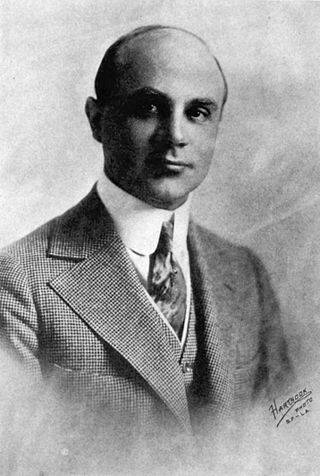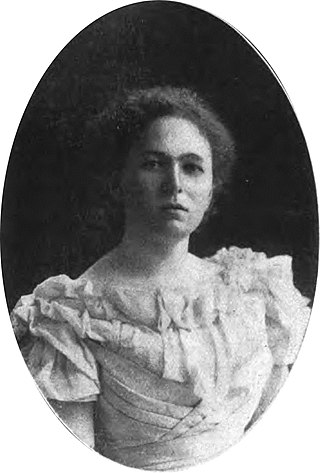
Cecil Blount DeMille was an American filmmaker and actor. Between 1914 and 1958, he made 70 features, both silent and sound films. He is acknowledged as a founding father of American cinema and the most commercially successful producer-director in film history. His films were distinguished by their epic scale and by his cinematic showmanship. His silent films included social dramas, comedies, Westerns, farces, morality plays, and historical pageants. He was an active Freemason and member of Prince of Orange Lodge #16 in New York City.

The Hollywood Heritage Museum, also known as the "Hollywood Studio Museum," is located on Highland Ave. in Hollywood, California, United States.

The Squaw Man is a 1914 American silent Western film directed by Cecil B. DeMille and Oscar C. Apfel, and starring Dustin Farnum. It was DeMille's directorial debut and one of the first feature films to be shot in what is now Hollywood.

Dustin Lancy Farnum was an American singer, dancer, and actor on the stage and in silent films. Although he played a wide variety of roles, he tended toward westerns and became one of the bigger stars of the genre.

Josephine M. Workman better known by her stage name, Princess Mona Darkfeather was an American actress who starred in Native American and Western dramas. During the silent era of motion pictures, from 1911 to 1917, she appeared in 102 movies. She is best known for her role as Prairie Flower in The Vanishing Tribe (1914).
Victor Milner, A.S.C. was an American cinematographer. He was nominated for ten cinematography Academy Awards, winning once for 1934 Cleopatra. Milner worked on more than 130 films, including dramas, comedies, film noir, and Westerns. He worked for large production companies like Metro-Goldwyn-Mayer, Universal, and Paramount during his film career.

Julia Faye Maloney, known professionally as Julia Faye, was an American actress of silent and sound films. She was known for her appearances in more than 30 Cecil B. DeMille productions. Her various roles ranged from maids and ingénues to vamps and queens.

Anne Bauchens, born Roseanne Bauchens, was an American film editor who is remembered for her collaboration over 40 years with the director Cecil B. DeMille. In 1940, she won the Academy Award for film editing.

The Squaw Man is a 1931 American pre-Code Western film directed by Cecil B. DeMille. It was his third time filming the same play but the first in sound. It stars Warner Baxter in the leading role.

Oscar C. Apfel was an American film actor, director, screenwriter, and producer. He appeared in more than 160 films between 1913 and 1939, and also directed 94 films between 1911 and 1927.

The Squaw Man is a 1918 American silent Western film directed by Cecil B. DeMille. It is a remake of DeMille's 1914 film of the same name, which is based upon a 1905 play by Edwin Milton Royle. The film was reportedly made as an experiment to prove DeMille's theory that a good film is based on a good story. It cost $40,000 to make and grossed $350,000. It would be remade again by DeMille in 1931.

The Squaw Man is a 1905 western/drama stage play in four acts written by Edwin Milton Royle.

Edwin Milton Royle was an American playwright. He was born in Lexington, Missouri, and died in New York City. Over 30 of his plays were performed. His best-known play is The Squaw Man (1905), which became the first Hollywood film directed by Cecil B. DeMille in 1914.

Wilfred Buckland was an American art director. Buckland worked as an art director with Cecil B. DeMille and Jesse Lasky, and later with Alan Dwan, from 1914 to 1927. He was Hollywood's first "art director" and is credited with a number of advancements in filmmaking, including the advances in lighting techniques, the development of architectural sets, and the use of miniature sets. In 1924, he was named one of the ten individuals who had contributed the most to the advancement of the motion picture industry since the time of its inception. A 1980 exhibition at the Victoria and Albert Museum in London advanced the argument that "everything we know as 'Hollywood' traces to Wilfred Buckland." Buckland was among the first inductees in the Art Directors Guild Hall of Fame.

Red Wing was an American actress of the silent era. She and her husband James Young Deer have been dubbed by some as one of the first Native American Hollywood "power couple(s)" along with Mona Darkfeather and her actor/director husband Frank E. Montgomery. St. Cyr was born on the Winnebago Reservation in Nebraska.

Winifred Kingston was a British-born American silent film actress.

Beulah Marie Dix was an American screenwriter of the silent and sound film eras, as well as a playwright and author of novels and children's books. She wrote for more than 55 films between 1917 and 1942. Dix married G. H. Flebbe at St. John's Chapel in Boston, Massachusetts on May 6, 1910.
Joseph J. Franz was an actor and film director during the silent film era in the United States. Franz was born in Utica, New York. He died in Los Angeles in 1970. He was sometimes credited as Joseph J. Franz. He features in a Frontier advertisement with two of the studio's other stars.
A Mohawk's Way, also known as The Mohawk's Treasure, is a 1910 short silent black and white drama film directed by D. W. Griffith, written by Stanner E.V. Taylor and based on James Fenimore Cooper novel, and photography by G.W. Bitzer. It stars Dorothy Davenport and Jeanie MacPherson.

Bison Film Company, also known as 101 Bison Film Company, is an American film studio established in 1909 and disestablished in 1917.

















